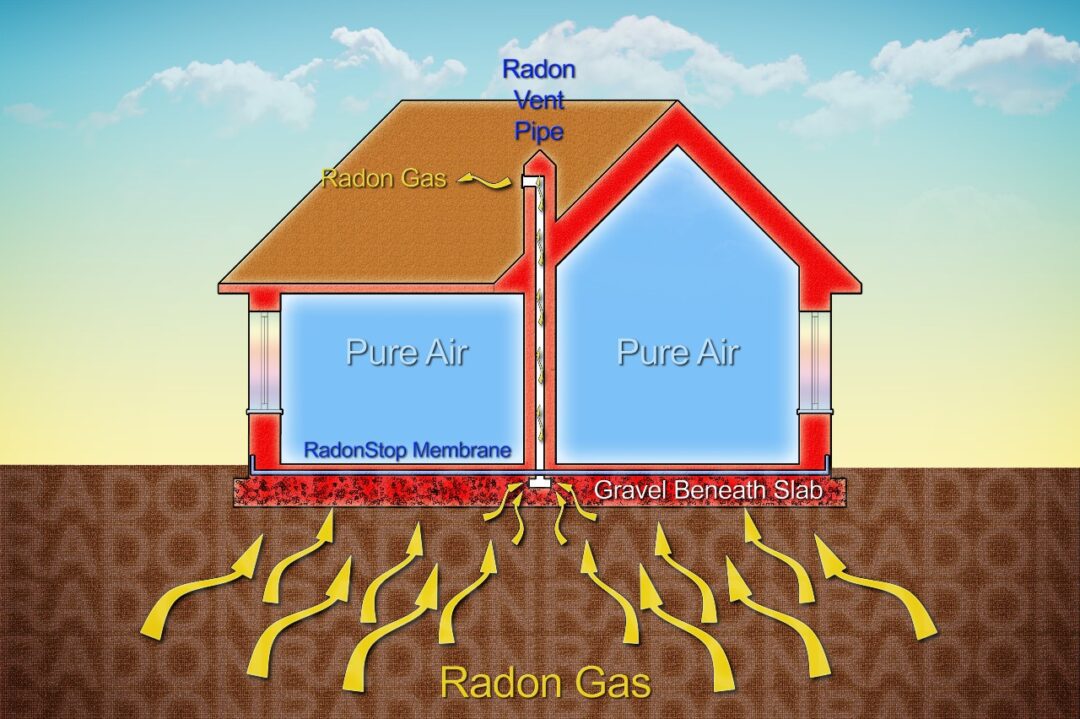Are there any dangers inside my home? |

People like to think of their home as a safe haven, a place where they can feel comfortable and secure. But our homes can pose risks to our well-being also. The ground on which houses stand, the materials from which they’re constructed, as well as the mechanical systems designed to improve our comfort all have a bearing on the safety of our homes.
Radon is formed by the natural radioactive decay of uranium in rock, soil, and water. It is colorless, odorless, and tasteless. Unless you tested for it, you would have no idea of its presence or its amount. The US Environmental Protection Agency has determined that most radon exposure occurs from the radon gas that moves up through the ground and into the home where it can build up to dangerous levels. It is found in all 50 states, although the amount of radon in the soil depends on soil chemistry, which varies widely from one location to the next. Radon gas decays into radioactive particles that enter the lungs when breathing. The energy released by these particles is capable of damaging the lungs and in some instances can lead to the development of lung cancer. Only cigarette smoking is more closely tied to the development of lung cancer. The amount of radon in the home can be determined with the use of in-home testing devices. Free test kits are sometimes available from local or county health departments or from your state American Lung Association. Methods to mitigate exposure to radon are available for home new construction as well as for older homes.
Volatile organic compounds (VOCs) Many building materials and products we have in our homes release or “off-gas” VOCs. Acetone, formaldehyde, benzene, and toluene are a few of the chemicals contained in these gases. Common construction materials capable of emitting VOCs include particle board, plywood, insulating foam, carpets, paints, sealing caulks, and vinyl floors. Products used in the home such as adhesives, air fresheners, cleaning agents, cosmetics, and moth balls can also cause elevated levels of VOCs. The different chemicals comprising VOCs each have their own toxicity and potential for causing adverse health effects. Temporary effects of VOCs include eye, nose, or throat irritation, allergic skin reactions, dizziness, headaches, and nausea. Even more concerning are long-term risks including cancer, and damage to the liver, kidney and brain produced by certain VOCs. The following suggestions will help to reduce your exposure to VOCs:
- Responsibly discard any partially full containers of old or unneeded chemicals or paints. Find out if your local government or any organization in your community sponsors special days for the collection of toxic household wastes.
- VOCs are concentrated in the home, increase ventilation when using products that emit VOCs. In some cases, VOC emitting items may need to be removed from the home.
- Keep exposure to cancer-causing VOCs to a minimum. These include benzene (from tobacco smoke, stored fuels and paint supplies, and automobile emissions), methylene chloride (from paint strippers, adhesive removers, and aerosol spray paints), and perchloroethylene (used in dry cleaning).
- Formaldehyde is one of the few indoor air pollutants that can be measured using a home test kit. If an elevated formaldehyde level is detected, identify, and if possible, remove the source.
Carbon Monoxide (CO) is a highly poisonous gas that is formed when carbon-containing substances (gas, oil, kerosene, wood, or charcoal) are burned with insufficient amounts of air. Automobiles, space heaters, ranges, ovens, stoves, furnaces, fireplaces, water heaters, and gas clothes dryers are all common sources of carbon monoxide production. Dangerous levels of CO can build up if appliances are not working or vented properly, leading to CO poisoning. Each year in the U.S., thousands of Emergency Room visits and hundreds of deaths result from accidental CO poisoning. At moderate levels, the symptoms of CO poisoning are headache, dizziness, weakness, nausea, vomiting, chest pain, and confusion. Higher levels of CO inhalation can result in loss of consciousness and death. Since carbon monoxide is a clear, colorless gas, it can be very difficult to detect without the use of CO detector. In addition to installation of CO detectors near sleeping areas and on every level of the home, the Centers for Disease Control offers the following suggestions to help prevent CO poisoning:
- Have your fuel-burning appliances (oil and gas furnaces, gas water heaters, gas ranges and ovens, gas dryers, gas or kerosene space heaters, fireplaces, and wood stoves) inspected by a professional at the beginning of every heating season.
- Choose appliances that vent their fumes to the outside and make sure that they’ve been properly installed.
- Read and follow instruction manuals that accompany fuel-burning devices.
- Don’t idle the car in a garage, even if the garage door is open
- Don’t use a gas oven to heat your home, even for a short time.
- Don’t use a charcoal grill indoors, even in a fireplace.
- Don’t sleep in any room with an unvented gas or kerosene space heater
- Don’t ignore symptoms, particularly if more than one person is experiencing them.
If you have any more questions just Ask Hanna, our health advisors are here to help.
Image: ©Shutterstock / Francesco Scatena








